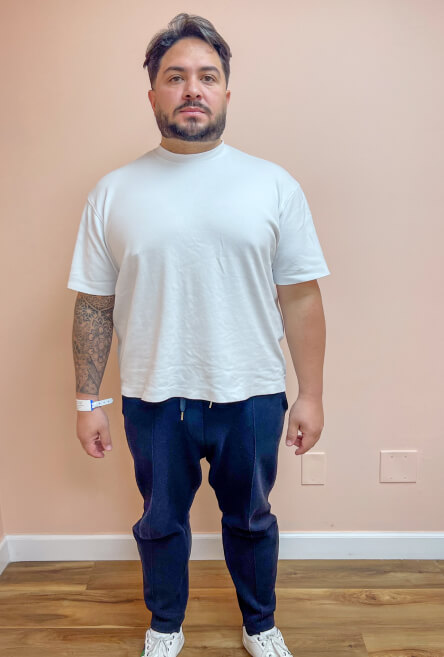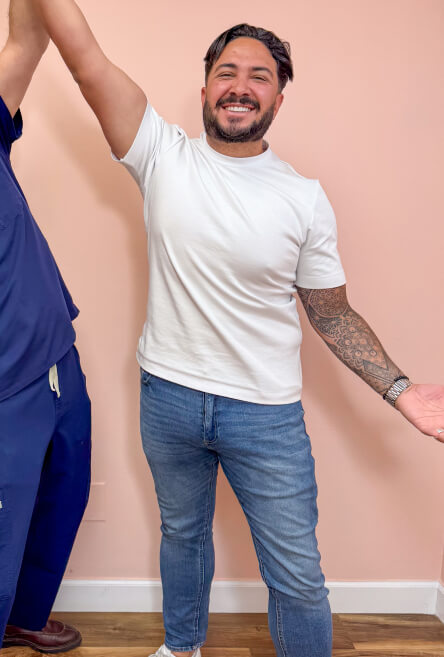Suture Sculpt
Endoscopic Sleeve Gastroplasty

What Is Suture Sculpt Endoscopic Sleeve Gastroplasty (ESG)?
Suture Sculpt endoscopic sleeve gastroplasty is a non-invasive and non-surgical procedure that reshapes and reduces the patient’s stomach size by 70-80%. The results of the procedure are similar to that of gastric sleeve surgery (VSG) but without all the associated surgical risks.

During the Suture Sculpt ESG procedure, the stomach is made much smaller and shorter. The smaller stomach size acts as portion control for the patient and only allows a small amount of food to be ingested during mealtime. The new shape of the stomach also slows down digestion and food stays in the stomach longer and helps patients feel satisfied and “full” for a long period of time promoting weight loss. The endoscopic sleeve promotes satiety and prolongs satiation!
Which Bariatric Surgeries Can Be Revised with Suture Resculpt?
Suture ReSculpt works for the revision of gastric sleeve (VSG) and gastric bypass (RYGB). If these bariatric surgeries have become ineffective and are no longer promoting weight loss, in an hour or less, we can correct the issues that have stopped your weight loss progress and give you a second chance to reach your weight loss goals.
The Suture ReSculpt non-surgical treatment aims to shrink both the sleeve and the stomach. It is an opportunity for those who have gained weight after a weight loss surgery to reach their body goals and maintain those goals long-term.

How Is the Suture Sculpt ESG Procedure Performed?

Suture Sculpt Endoscopic Sleeve Gastroplasty is performed using an endoscope and a special suturing device. With the patient sedated, the endoscope is lowered down the patient’s throat to gain access to the stomach.
The endoscope allows a physician to view the stomach through the camera. The walls of the stomach are usually marked up with a special device and then the patient’s stomach size is reduced to about 70-80% of its original size by using sutures.
The Physician reshapes the stomach using the overstitch suturing device to strategically place a series of 4 to 12 sutures in the stomach and makes it shorter and smaller. Through the process, the natural blood & nerve supply and intestinal continuity remain unaltered.
Patients are monitored for a few hours post-procedure and then discharged to return home.
How Much Weight Can I Expect to Lose with Suture Sculpt?
The average patient loses between 21-28% of their total body weight or 60-70% of the excess body weight they are carrying.
Excess body weight is the difference between the patient’s current weight and their ideal weight. For instance, a patient who weighs 250 pounds and has an ideal weight of 150 pounds is carrying 100 pounds of excess weight. If they lose about 70% of the excess weight in a year post-procedure, they will weigh approximately 180 pounds.
The patient’s degree of dedication to making permanent lifestyle changes that include a healthy low-calorie diet and plenty of exercise will help determine the weight loss potential. Many of our patients have lost close to 100 pounds in only 12 months after having the Suture Sculpt ESG procedure.
Suture Sculpt Weight Loss Patients


Carlos A.


Monica M.


Daniella W.
Who Is a Candidate for Suture Sculpt?
- Patients who normally have a BMI of 27 or higher and have not been successful with traditional diets;
- Patients who do not wish to undergo surgery or could not have the surgery due to health reasons;
- Patients who may not qualify for traditional weight loss surgeries.
What Is Covered by the Cost of the Suture Sculpt Procedure?
At Batash Endoscopic Weight Loss Center, we know that financial restrictions can make it challenging to obtain the treatment you need and deserve so we offer CareCredit and United Medical Credit financing to our patients. Different procedure packages can be designed to accommodate unique patient needs.
One of our expert team members would be happy to discuss the cost of the procedure and financing options with you and answer any questions you may have.
The cost of Suture Sculpt ESG at Batash Endoscopic Weight Loss Center includes:
- The Suture Sculpt procedure
- Anesthesia done for the procedure
- Pre- and post-op care
- Ongoing support and monitoring for a full year and access to comprehensive nutritional coach
Is the Suture Sculpt ESG Covered by Insurance?
At this time Suture Sculpt is not covered by insurance. Historically, new procedures that are born through advancements in medicine are rarely embraced quickly by insurance companies.
Endoscopic Sleeve Gastroplasty in New York and Miami

New York

Miami
How Does Suture Sculpt Compare to the Surgical Sleeve?
Endoscopic Sleeve Gastroplasty is a minimally invasive non-surgical procedure whereas gastric sleeve is surgery that entails a higher rate of risks and complications than ESG. Suture Sculpt is a safe and effective way to lose weight and avoid obesity-related diseases such as type 2 diabetes mellitus, hypertension, heart disease, and many others.
Compared to bariatric surgeries that have a significant rate of failure and unsatisfactory results, ESG gives an opportunity to lose about 21-28% of total body weight in a year with minimum risks. There are many other reasons why Suture Sculpt ESG is a better option than weight loss surgery.
What Happens After the Suture Sculpt Procedure?
At Batash Endoscopic Weight Loss Center, patients are not left to make it on their own once the procedure has been completed, we are here to support you along your weight loss journey.
To ensure patient success in achieving their weight loss goals, we provide ongoing nutritional support and monitoring for 1 year, as well as lifetime access to our OnTrack wellness program. The OnTrack program is specifically designed to help our patients achieve their goals and maintain long-term weight loss.
As with other weight loss procedures, Suture Sculpt works best when combined with a longstanding commitment to a healthy diet and lifestyle that includes regular exercise.
FAQs
The ESG is carried out via endoscopy, which means that it’s done through your mouth and down your throat. Everything is done from the inside of your stomach, rather than the outside of it.
Technically, yes! An endoscopy is non-surgical. No incisions are made whatsoever.
Yes, you are likely to have some discomfort for a couple of days. However, in comparison to other weight loss surgeries, the level of discomfort is far lower. We will provide you with safe pain-relief measures if needed.
The recovery from an ESG procedure is extremely fast, compared to other weight loss procedures. You should be capable of returning to work within only a couple of days.
As the ESG is carried out via endoscopy, there is no scarring! No incisions or wounds are made through this procedure.
The procedure is carried out under general anesthetic, so we would advise no driving for 24 hours afterwards. Have someone ready to provide you with a ride immediately following the procedure.
The ESG doesn’t change the absorption of nutrients from food, as your intestines remain unchanged. However, you will be eating a lot less food. Therefore, we advise patients to take a daily multivitamin.
Exercise and physical activity are very much encouraged following your procedure. The ESG limits you in no way with this, whether you decide to walk for 5 minutes or run a marathon!
In general we’ve tracked 15% of total body weight loss in the first six months; 18% total body weight loss in the first 12 months; and 24% total body weight loss in the first 24 months. This type of sustained weight loss is better than overly rapid weight loss because it allows the body and skin to adjust better to the change. Many people lose much more than the initial 18%. The level of success is highly dependent of the level of commitment to a healthy lifestyle and portion control.

